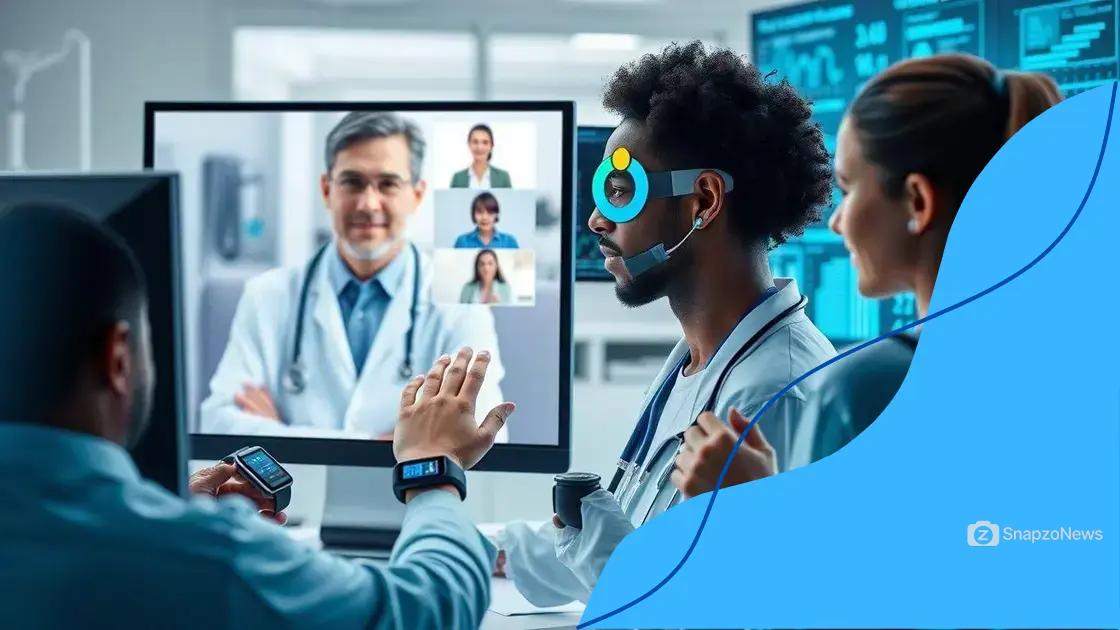The US response to emerging global health challenges

The US response to emerging global health challenges involves enhancing surveillance systems, strengthening health infrastructure, and fostering collaboration to effectively prepare for and address health crises.
The US response to emerging global health challenges is more important than ever. As we face new diseases and health threats, it’s vital to examine how we can effectively prepare and respond. Curious about what this means for you? Let’s dive deeper.
Understanding global health challenges
Understanding global health challenges is vital in today’s interconnected world. These challenges can arise from various sources such as infectious diseases, environmental factors, and health disparities. Each issue needs a tailored approach to ensure effective responses.
Key Global Health Challenges
Several factors contribute to today’s health challenges, significantly impacting communities around the globe. Among these issues, we find:
- Infectious diseases: Outbreaks like COVID-19 have shown how quickly diseases can spread across borders.
- Chronic diseases: Conditions such as diabetes and heart disease continue to rise, affecting quality of life.
- Health disparities: Inequities in healthcare access still exist, creating gaps in health outcomes.
Another critical aspect is environmental influences on health. Pollution and climate change not only impact air and water quality but also contribute to health issues like asthma and allergies. As global temperatures rise, the prevalence of vector-borne diseases, such as malaria and dengue fever, may also increase.
Technological Influences
Technology plays a significant role in tackling these challenges. Innovations like telemedicine have made healthcare more accessible, especially in remote areas. It enhances preventive measures by allowing patients to consult healthcare providers from home. This can lead to earlier diagnosis and better health management.
Furthermore, data analytics can help identify trends and potential outbreaks. Through the effective use of big data, health organizations can monitor health threats and devise timely responses. Collaboration between governments, NGOs, and tech companies is essential to harness these technological advancements for better health outcomes.
The understanding of global health challenges is continuously evolving. By staying informed and adaptive, communities can better prepare for unforeseen health crises. Open discussions about these issues can foster partnerships and encourage proactive solutions.
Recent examples of health crises
Recent examples of health crises highlight the importance of swift and effective responses. Events such as the COVID-19 pandemic have profoundly impacted the global landscape. Understanding these crises can help in preparing for future outbreaks.
The COVID-19 Pandemic
The emergence of COVID-19 in late 2019 rapidly escalated into a global health crisis. This virus affected millions, shutting down economies and disrupting daily life. Essential lessons were learned about the need for rapid testing, contact tracing, and vaccine development. Global collaboration was crucial in sharing resources and information to address the crisis.
- Testing and Vaccination: The swift creation of vaccines demonstrated the power of scientific innovation. Countries raced to develop vaccines and implement mass vaccination campaigns.
- Public Health Messaging: Clear communication was vital in guiding public behavior. Misinformation spread quickly, highlighting the need for reliable sources.
- Healthcare Systems: The pandemic strained healthcare resources, revealing gaps in many health systems that require attention.
Another recent health crisis was the Ebola outbreak in West Africa from 2014 to 2016. Although it occurred several years ago, its impact is still relevant today. The outbreak led to significant loss of life, sparking fear and social disruption. It showcased the need for better preparedness, faster response times, and improved healthcare practices in affected regions.
Lessons from Recent Health Crises
Learning from these health crises is essential for building resilience. Governments and health organizations must develop better frameworks for handling future emergencies. Improved surveillance systems can help in early detection of outbreaks, allowing for quicker interventions. Investing in global health infrastructure is crucial, as it can mitigate the effects of pandemics.
In conclusion, understanding recent health crises such as COVID-19 and Ebola informs future preparedness efforts. By analyzing these events, we can foster a global health environment that prioritizes health and readiness.
The role of technology in health solutions

The role of technology in health solutions has become increasingly vital in addressing complex health challenges. Innovations in this field have transformed healthcare delivery and improved patient outcomes. From telemedicine to wearable devices, technology plays a crucial part in modern healthcare.
Telemedicine’s Impact
Telemedicine allows patients to connect with healthcare providers remotely, making healthcare more accessible. This technology has proven especially beneficial during health crises, like the COVID-19 pandemic. Patients can receive care without visiting hospitals, reducing their exposure to infections.
- Convenience: Patients can schedule appointments from home, saving time and travel costs.
- Access: Rural areas gain better access to specialist care.
- Continuity of care: Regular follow-ups can be managed easily through virtual visits.
Moreover, wearable technology continues to gain popularity. Devices like fitness trackers and smartwatches monitor vital signs and physical activity. This data helps individuals manage their health more proactively. Healthcare providers can also use this information to tailor treatments.
Data Analytics in Healthcare
Data analytics is another cutting-edge technology enhancing health solutions. By analyzing large sets of data, healthcare organizations can identify trends and make informed decisions. This helps in predicting outbreaks and improving patient care. For instance, hospitals use data analytics to streamline operations and reduce wait times.
Integration of electronic health records (EHR) allows for seamless sharing of patient history. This technology leads to better coordination among healthcare providers, preventing medical errors. It also supports personalized medicine, where treatments are tailored to individual needs based on comprehensive data analysis.
In conclusion, technology is reshaping health solutions in transformative ways. From improving access to care through telemedicine to enhancing preventative measures with wearables, its role cannot be overstated. Embracing these innovations may lead to a healthier future for all.
Collaborative efforts in public health
Collaborative efforts in public health are essential for tackling complex health challenges. These partnerships unite various sectors to improve health outcomes and respond effectively to crises. When organizations work together, they can combine resources and expertise, leading to powerful public health solutions.
Interagency Collaboration
Government agencies often collaborate to address public health issues. For example, the Centers for Disease Control and Prevention (CDC) teams up with local health departments to manage disease outbreaks. This collaboration ensures a unified response, drawing on local knowledge and data.
- Data sharing: Collaborating agencies can share critical data, improving speed and accuracy in responses.
- Resource allocation: Joint efforts allow for better use of resources, targeting high-need areas effectively.
- Public awareness: Together, agencies can create clearer messaging to educate communities on health issues.
Another example is partnerships between public health organizations and private companies. These collaborations can bring innovative solutions to pressing health challenges. For instance, tech companies can provide valuable tools for tracking disease spread or enhancing telehealth services.
Community Engagement
Community engagement is a crucial aspect of public health collaboration. Involving local community organizations fosters trust and strengthens initiatives. Communities know their unique needs better than anyone else. Therefore, working with them leads to more tailored solutions.
Public health campaigns that include community input are more effective. They resonate with the target audience and encourage participation. For example, during vaccination drives, understanding community concerns helps shape messaging and outreach strategies.
Lastly, international collaborations are vital, especially for handling health crises that cross borders. Global partnerships between countries and organizations enhance resources and expertise. These collaborations have been crucial in controlling outbreaks, such as Ebola and COVID-19, demonstrating the strength of unity in public health efforts.
Future strategies for health preparedness
Future strategies for health preparedness are crucial as the world faces new and emerging health threats. As we’ve seen during recent global health crises, being prepared can make a significant difference in outcomes. It requires a comprehensive approach to strengthen health systems.
Enhancing Surveillance Systems
One key strategy is to enhance surveillance systems. Early detection of health threats can lead to prompt action. Investing in technology that tracks disease outbreaks in real-time is vital. This includes the use of big data analytics and artificial intelligence to identify patterns and predict outbreaks before they escalate.
- Integration: Combining data from various sources can provide a clearer picture of emerging health threats.
- Community reporting: Empowering citizens to report unusual health events can improve local responses.
- Global networks: Collaborating with international health organizations allows for shared knowledge and resources.
Education and training also play an essential role in preparedness. Health professionals need ongoing training to stay updated on best practices and emerging health threats. This includes simulations and exercises that prepare them for crisis scenarios. Public education campaigns can also equip communities with knowledge on how to respond to health emergencies.
Strengthening Health Infrastructure
Another critical element is strengthening health infrastructure. Investing in healthcare facilities, especially in underserved areas, ensures they can handle sudden surges in patients. This includes ensuring access to essential resources like vaccines, medications, and medical equipment.
A robust health infrastructure must also focus on mental health services, as crises can lead to increased stress and anxiety among populations. Providing support services for mental health is a crucial component of overall health preparedness.
Lastly, fostering partnerships between governments, private sectors, and communities will create a unified front in tackling health threats. Collaborative planning and resource-sharing can lead to more resilient health systems, capable of responding to both current and future challenges effectively.
In conclusion, effective health preparedness is essential for safeguarding communities against future health challenges. By enhancing surveillance systems, strengthening health infrastructure, and fostering collaboration, we can build resilient healthcare systems. Additionally, investing in education and training ensures that both professionals and communities are ready to respond effectively to crises. With united efforts and proactive strategies, we can create a healthier and safer future for all.
FAQ – Frequently Asked Questions about Health Preparedness
What are the key strategies for health preparedness?
Key strategies include enhancing surveillance systems, strengthening health infrastructure, providing education and training, and fostering collaboration.
How can technology improve health preparedness?
Technology enhances health preparedness through better data tracking, telemedicine, and efficient communication systems, allowing for quick responses to health threats.
Why is community engagement important in public health?
Community engagement is vital because it fosters trust, ensures that health initiatives meet local needs, and encourages participation in health programs.
How can we ensure effective collaboration in public health efforts?
Effective collaboration can be ensured by building strong partnerships between government agencies, organizations, and communities, as well as sharing resources and information.
